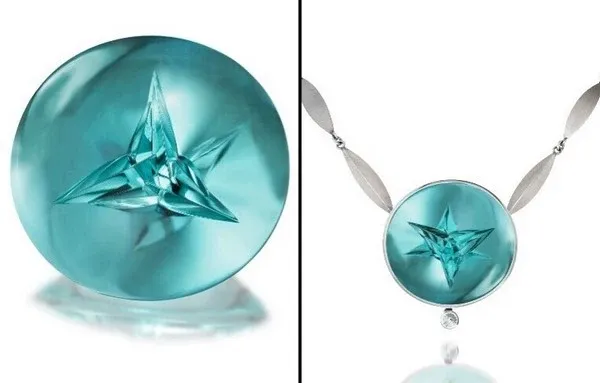The Paraiba tourmaline is a rare and highly coveted type of tourmaline, known for its vivid blue-green colors, often described as “neon” or “electric.” These unique hues of Paraiba tourmaline gemstone are a result of trace amounts of copper and manganese, distinguishing it from other gemstones.
As for the tourmaline meaning the term denotes a mineral with varying colors or stone with the mixed colors, composed of a complex borosilicate, and is prized as a gem when transparent and cut. While, the name “Paraiba” originates from its place of origin, a state in northeastern Brazil, characterized by a coastal strip, hills, and inland plains with irrigated agriculture.
Paraiba tourmalines are regarded as one of the most valuable gemstones globally due to their exceptional beauty, rarity, and the challenges involved in their extraction.
Tourmaline vs. Paraiba Tourmaline
The main contrasts between tourmaline gemstones and Paraíba tourmaline gemstones are found in their chemical makeup, color, scarcity, and worth. Here’s a detailed look at the main differences:
1. Chemical Composition:
| Tourmaline | Paraíba Tourmaline |
|---|---|
| Tourmaline is a fascinating boron silicate mineral that contains a variety of elements such as aluminium, iron, magnesium, lithium, and potassium. It can be found in different varieties, each exhibiting distinct chemical compositions that give rise to a diverse range of colors. | The Paraíba tourmaline is renowned for its vibrant neon blue, green, or turquoise hues, because of its high copper and often manganese content. This unique composition sets it apart from other tourmalines and is the primary reason behind its exceptional coloration. |
2. Color:
| Tourmaline | Paraíba Tourmaline |
|---|---|
| Tourmalines come in a range of colors, including black (schorl), pink (rubellite), green (verdelite), blue (indicolite), yellow, and multicolored varieties. However, their colors are typically more subdued compared to Paraíba tourmaline, which is known for its vibrant and luminous colors. | The Paraíba tourmalines are renowned for their striking neon or electric blue, green, and turquoise hues, often characterized as “glowing” or “electric” due to the presence of copper trace element, a rarity in other tourmalines. The exceptional color intensity of Paraíba tourmaline makes it extremely desirable in the gemstone market. |
3. Rarity:
| Tourmaline | Paraíba Tourmaline |
|---|---|
| Tourmaline is found in many regions around the world and comes in different varieties, some of which are rarer than others. For example, black tourmaline (also known as schorl) is quite common, while pink or watermelon tourmaline is considered to be rare. | Paraíba tourmaline is an extremely rare gemstone, much rarer than most other types of tourmaline. It was first found in small amounts in Paraíba, Brazil, and later in Nigeria and Mozambique. The Brazilian deposits are almost exhausted, making the gemstone even scarcer and more valuable. |
4. Value:
| Tourmaline | Paraíba Tourmaline |
|---|---|
| Tourmalines can be found in various parts of the world such as Brazil, Madagascar, Sri Lanka, the United States, and Africa, with each location yielding tourmalines of different colors and qualities. | Paraíba tourmalines were initially found in Paraíba, Brazil in 1989. Later on, tourmalines with similar characteristics, including the presence of copper, were discovered in Nigeria and Mozambique in the early 2000s. While African Paraíba tourmalines are also admired for their rich hues, the Brazilian Paraíba tourmalines are typically the most sought after because of their origin and historical importance. |
6. Luminescence:
| Tourmaline | Paraíba Tourmaline |
|---|---|
| Most tourmalines are known for their vivid colors, but they generally lack the distinctive glowing quality that sets Paraíba tourmalines apart. | Paraíba tourmalines are renowned for their captivating neon glow and internal fire, which sets them apart even in dim lighting. This remarkable radiance is a unique characteristic of these copper-bearing gemstones, adding to their allure and value. |
Where is Paraiba Tourmaline Found?
The Origins of Paraiba Tourmaline
Origin
Besides the Paraiba Mountains in Brazil and Nigeria, bright blue tourmalines are found in Mozambique and other parts of the world. New deposits have been discovered in Brazil and eastern Africa, which is positive for gemstone dealers struggling to meet demand due to its extreme rarity.
The composition of the newly discovered Paraiba stones is similar to the Paraiba variant. Brazilian stones are still the rarest and most vibrant, commanding the highest value in the market.
Geology
The majority of tourmaline mining sites in Brazil’s Paraiba region are in primary deposits found in pegmatites invading quartzites or metaconglomerates around 530-480 million years ago.
In Mozambique and Nigeria, tourmalines are extracted from secondary alluvial deposits. The gemological characteristics and inclusions of Paraiba tourmaline are similar between primary and secondary deposits, indicating a comparable geological genesis for copper-bearing tourmalines from both continents. The source of the copper in Brazilian Paraiba tourmaline locations is still unknown.
History of Paraiba Tourmaline
The stunning Paraiba Tourmaline was unearthed in the 1980s in Brazil. Heitor Dimas Barbosa and his dedicated team are credited with this remarkable discovery.
Mr Barbosa led the team in extensive excavation efforts in the Paraiba hills for over five years, driven by an unwavering belief that they would uncover something truly unique and precious. Their perseverance paid off when they finally unearthed the breathtaking Paraiba tourmaline, causing a sensation worldwide.
Why Paraiba tourmaline is named as Paraiba tourmaline?
This vivid blue gemstone was unearthed in the Brazilian Pairaba Hills, and it was aptly named after its place of origin. The Paraiba Tourmaline quickly gained worldwide popularity due to its unmatched beauty, brilliance, and rarity. It particularly captured the attention of the Japanese, who have always had a high demand for such unique gemstones.
The discovery of Paraiba gemstones triggered intense mining on Paraiba Hill, a small area measuring only 400 meters in length, 200 meters in width, and 65 meters in height. Initially, miners unearthed numerous tourmaline deposits. However, five years after the discovery of Paraiba tourmaline stones, extensive searches of the entire hill yielded nothing.
Is Paraiba Tourmaline Found Outside Brazil?
In 2001, a surprising discovery was made in Nigeria – a bright blue stone that reignited the Paraiba tourmaline story. These vibrant blue stones quickly gained popularity in the market, similar to their Brazilian Paraiba counterparts, after undergoing an intense burning process that revealed their true, vivid blue color.
The Paraiba stones were sent to laboratories to analyze their chemical composition and structure, confirming the claims of gemstone enthusiasts that both stones, discovered in different locations, were indeed the same!
The Colors of Paraiba Tourmaline
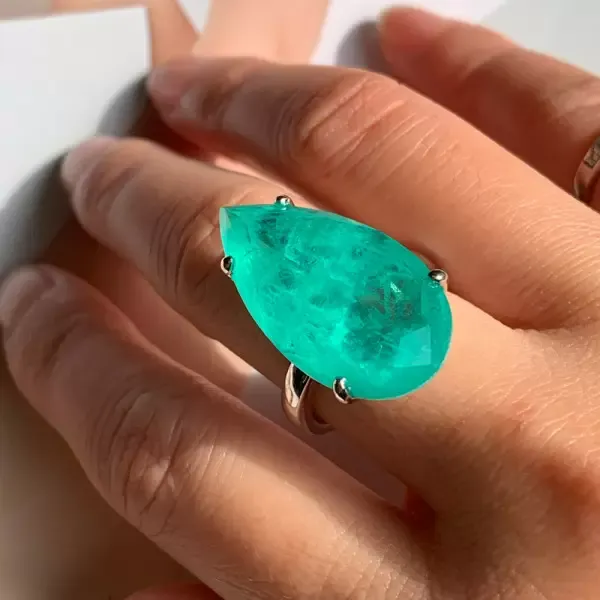
The Paraiba tourmaline displays a striking variety of colors, including vibrant neon blue, electric green, intense turquoise, and sometimes even violet or purple because they are formed under intense geological conditions in pegmatite veins, which are coarse-grained igneous rocks that form during the final stages of magma crystallization.
Paraiba tourmalines are prized for their stunning range of colors, reminiscent of the crystal-clear waters of the Caribbean. These precious gemstones exhibit a spectrum of hues, including greenish-blue paraiba tourmalines, bluish-green paraiba tourmalines, green Paraiba tourmalines, blue paraiba tourmalines, and violet paraiba tourmalines.
Gemstone experts use terms like “neon,” “electric,” “sky blue,” “baby blue,” “arctic blue,” “teal blue,” “mint green,” “seafoam green,” “lime green,” and “turquoise” to describe the extraordinary colors of paraiba tourmaline. The interplay between copper and manganese gives these gemstones their captivating colors, with variations in concentration and proportions resulting in different shades and saturations.
Color varieties of Tourmaline
The tourmaline gem family showcases a stunning array of colors. There are six distinct varieties with unique trade names:
1. Rubellite: This type of tourmaline encompasses pink, red, purple-toned red, orange-toned red, and brown-toned red tourmaline.
2. Indicolite: This variety includes violet-blue tourmaline and some with a green-blue hue.
3. Paraíba: Known for its intense color, this type refers to green-blue and blue tourmaline from the state of Paraíba, Brazil.
4. Chrome: This tourmaline is characterized by an intense green color, mainly colored by vanadium, the same element that gives color to numerous Brazilian and African emeralds.
5. Parti-colored: This variety displays multiple fantastic colors in one stone.
6. Watermelon: This type of tourmaline features a pink core and a green ring surrounding it. Crystals of this variety are often sliced to reveal their unique multi-colored beauty.
What is the Rarest Color of Paraiba Tourmaline?
Neon blue paraíba tourmaline and green paraíba tourmaline get their vibrant neon blue and green colors from the presence of copper. While manganese is responsible for the pink and purple varieties of this tourmaline gemstone. The unique combination of these trace elements gives Paraíba tourmalines their distinct color intensity, setting them apart from other tourmalines.
Why is Neon Blue Paraiba Tourmaline So Special?
The most desirable paraiba tourmalines display vibrant neon blue hues with intense saturation and a moderate tone. Some of these gemstones may also show a secondary green tint, which can affect their value. Generally, pure blue stones are more valuable than those with green or blue-green tints.
Paraiba tourmalines with less popular colors, like pink and violet, are more affordable due to lower demand. Additionally, Brazilian blue stones or Neon Blue paraiba tourmalines from Brazil are typically more expensive than those from Mozambique and Nigeria, as they are more vividly saturated.
What Does Paraiba Tourmaline Symbolize?
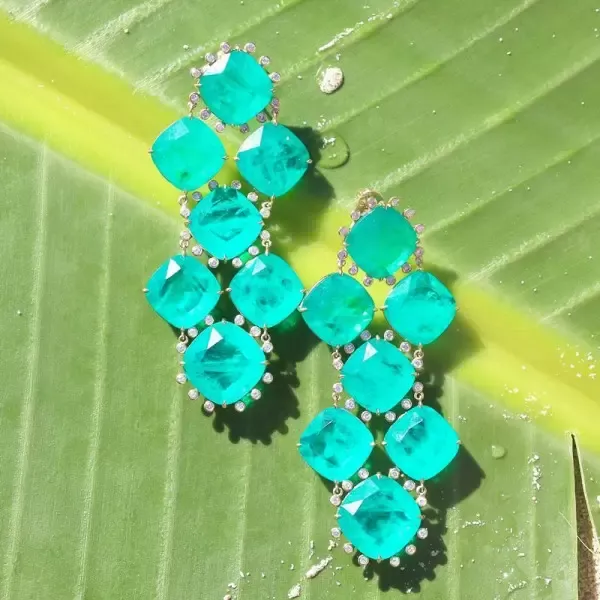
In various cultures, paraíba tourmaline is considered to be the birthstone for individuals born in October. Symbolically, this precious gem represents wisdom, communication, intuition, and innovation. Generally, gemstones with a blue hue are associated with tranquility, stability, and peace. Some people believe that this stone possesses metaphysical qualities, promoting mental clarity, fairness, and empowerment.
It is thought that paraiba tourmalines can help energize and harmonize the body’s energy centers, drawing in the inspiration necessary to achieve aspirations. Additionally, the stone is believed to reduce fear, and enhance concentration, and motivation. It is also said to enhance understanding and increase the wearer’s self-assurance for those who have faith in its abilities.
The Spiritual and Symbolic Meaning
Tourmaline has a fascinating history of symbolism across various cultures due to its diverse colors and properties. This has resulted in a wide range of meanings and associations attributed to this gemstone.
1. Protection and Grounding
Black tourmaline is considered spiritual tourmaline as it is highly protective, and believed to repel negative energy and ward off evil. It also acts as a grounding stone, helping maintain emotional balance, particularly during stress and anxiety.
2. Healing and Balance
Tourmaline is known for promoting emotional healing, soothing fears, alleviating stress, and bringing calm and stability. It is also believed to balance the body’s energy centers, or chakras, especially in crystal healing. Different colors of tourmaline are associated with specific chakras:
- – Pink Tourmaline: Heart chakra (love and compassion)
- – Green Tourmaline: Heart chakra (healing and vitality)
- – Blue Tourmaline: Throat and third-eye chakras (communication and intuition)
3. Love and Compassion
Pink Tourmaline, also known as Rubellite, is associated with love, emotional healing, and compassion. It opens the heart to give and receive love, and is worn to attract romantic love or strengthen relationships. It also encourages self-compassion, emotional balance, and healing from past traumas, fostering personal growth and well-being.
4. Creativity and Inspiration
Tourmaline is thought to enhance creativity, artistic expression, and open-mindedness, helping to overcome creative blocks and provide inspiration.
5. Courage and Confidence
Red or Pink Tourmaline (Rubellite) is believed to promote courage, strength, and self-confidence, as well as personal power, vitality, and resilience in facing challenges.
6. Spirituality and Insight
Blue Tourmaline, also known as Indicolite, is associated with spiritual awareness, insight, and psychic abilities. It is often used in meditation to deepen understanding, enhance communication with the spiritual realm, and develop intuition. This gemstone strengthens the connection to higher spiritual realms and encourages clear communication with one’s inner self and the divine.
7. Multicolored Tourmaline (Watermelon Tourmaline)
Watermelon tourmaline symbolizes the balance between the heart and mind, promoting emotional harmony and a sense of wholeness. It is also associated with joy, playfulness, and positive energy, boosting vitality and mood.
8. Ancient Symbolism
Ancient Egyptians believed that tourmaline traveled through a rainbow, representing unity and diversity. In Indian traditions, tourmaline was revered as a stone of enlightenment, bringing insights during meditation and opening the mind to higher wisdom.
9. Prosperity and Abundance
Verdelite, or green tourmaline, is associated with prosperity, abundance, and success, attracting wealth and promoting personal and professional growth through perseverance and positive thinking.
How to Identify a Real Paraiba Tourmaline?
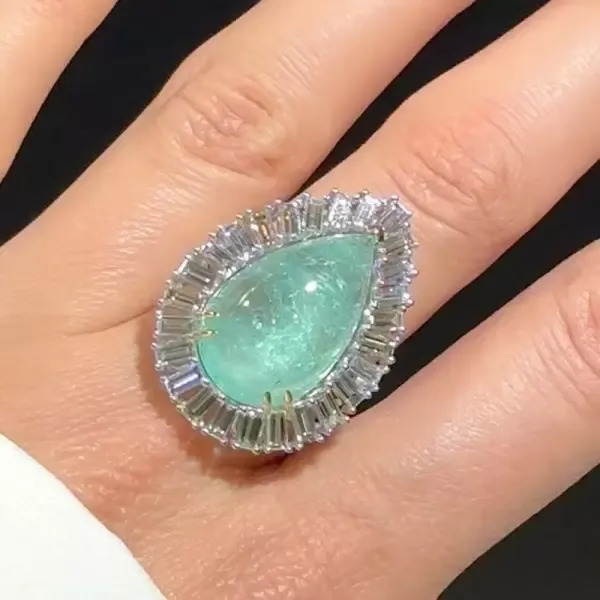
To identify the real paraiba tourmaline you need to know the 4 C’s – Color, Clarity, Cut, and Carat Weight:
1. Color
An authentic Paraiba tourmaline is instantly recognizable by its vibrant, electric blue color, unmatched by any other gemstone. The finest quality Paraiba, free of inclusions, is the most expensive in the tourmaline family. For a more affordable option, consider greenish-blue, bluish-green, or green Paraibas, which are still rare but less costly than the pure blue varieties.
Color, not size, is the main factor in determining the stone’s price. A small, bright blue Paraiba will often be more valuable than a larger tourmaline of another color due to the premium placed on its intense color.
2. Clarity
Paraíba tourmalines form under rare conditions in a liquid-rich environment, leading to the formation of inclusions of tiny trapped elements within the stone.
These inclusions, often visible as thread-like or tube-like cavities, contain liquid or gas bubbles. While they may affect the stone’s clarity and value, they can be easily seen under magnification and are a natural characteristic of Paraiba tourmalines.
3. Cut and shape
Natural Paraíba tourmalines are carefully cut to enhance their market value. Skilled cutters use heated cutting techniques to remove imperfections without damaging the stone. Ovals are a popular shape, as this cut minimizes waste by aligning with the stone’s length. Since tourmalines are pleochroic, meaning they show different colors from different angles, they absorb more light along their length than across their width.
This causes the gemstone to appear paler along its length but more vivid across its width. To enhance color, cutters adjust the cut based on the stone’s depth, making it appear darker or lighter as desired.
4. Carat weight
Tourmalines with unique designs can be found in larger sizes, but their availability relies on the color and quality of the stone. It’s rare to find large-sized tourmalines, and when they are found, they command high prices
For a tourmaline to grow large, it requires consistent heat and pressure over millions of years. Without the proper conditions and space, the stone will remain small. Paraíba tourmalines, in particular, are seldom found over 2 carats, whereas other colored tourmalines are more commonly found in sizes exceeding 5 carats.
Natural vs. Synthetic Paraiba Tourmaline
- Determining the authenticity of a Paraiba tourmaline can be challenging without gemological testing. However, there are several indicators to consider:
- Price Discrepancy: Synthetic paraibas are typically more affordable. If the price seems unusually low, it may suggest a synthetic stone.
- Origin Verification: Real Brazilian Paraibas are rare and valuable. Exercise caution if a stone is purported to be from Brazil without proper documentation.
- Inclusion Patterns: Natural Paraibas often exhibit needle-like or fingerprint-like inclusions. Synthetic stones may lack these or show different patterns.
- Color Consistency: Synthetic paraibas tend to have a uniform color, while natural ones may display color variations or zoning.
- Expert Examination: A certified gemologist or lab can conduct advanced tests, such as spectroscopy, to confirm authenticity.
Why is Paraiba Tourmaline So Expensive?
The extreme rarity of Paraiba tourmaline makes it super expensive. The most sought-after are the blue ones from Brazil due to their intense color saturation, attractive hues, and exceptional rarity. The price is influenced by factors such as origin, brightness, color saturation, and the stone’s inclination towards the blue shade, rather than its size.
High-quality tourmalines without inclusions command a high price, while those with inclusions are relatively less expensive. Mining Paraiba tourmaline is challenging due to the delicate crystals, and most deposits are mined manually with hand-held tools to avoid damage.
Paraiba Tourmaline Value and Pricing per Carat
As for the price of Paraiba tourmaline it is a semi-precious gemstone but it is even rarer than the precious gemstone diamond. It’s estimated that one paraiba tourmaline is mined for every 10,000 diamonds mined. So, is paraiba tourmaline more expensive than diamond? Well, it varies depending on the diamond.
High-quality white diamonds weighing 5 carats or more can be sold for up to $68,000 per carat, while high-quality paraiba tourmalines in the same weight category can fetch up to $87,000 per carat.
Cultural and Market Impact
The discovery of Paraíba tourmaline revolutionized the gemstone market. Its distinct color quickly became a sought-after characteristic and it was used in high-end jewelry collections by famous designers. Today, Paraíba tourmaline remains a symbol of luxury, rarity, and natural beauty.
How to Care for Paraiba Tourmaline?
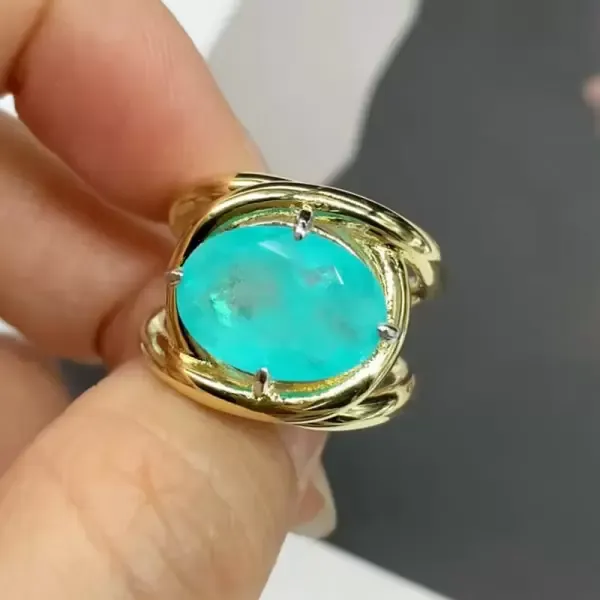
Here are some important care tips for maintaining the beauty and durability of your Paraiba tourmaline jewelry:
- Avoid exposing your jewelry to makeup, harsh chemicals, moisturizers, and abrasives. It’s best to remove your jewelry when in contact with these substances and avoid wearing it while swimming, bathing, exercising, or gardening to prevent scratching or chipping.
- Clean your Paraiba tourmaline by soaking it in lukewarm water mixed with mild cleaning detergent. Use a soft toothbrush to gently clean the jewelry, then rinse and dry it with a soft cloth. For heavily soiled jewelry, you may need to repeat the cleaning process.
- Store your Paraiba tourmaline jewelry separately to prevent scratching, and keep it away from heat and direct sunlight. For everyday rings, such as engagement rings, it’s recommended to perform a weekly check to ensure the center gem is secure.
- We highly recommend annual maintenance for your Paraiba tourmaline jewelry, including professional tightening of gems and cleaning. This will help ensure the longevity of your jewelry.
- Avoid using commercial jewelry cleaners or ultrasonic cleaners on your Paraiba jewelry, as these methods may not be suitable for cleaning this type of gemstone.
Treatment of Paraiba tourmalines
Untreated Paraiba tourmalines are highly uncommon and challenging to come by. Most local jewelry stores typically offer heated Paraiba tourmalines due to limited availability. Treatments are used to enhance or alter the color of a tourmaline. These treatments include traditional processes of cutting and polishing to enhance the gem’s appearance and durability.
In the trade, when someone asks for a Paraiba tourmaline, it is generally understood that they are referring to a heated gemstone. Heating a Paraiba tourmaline is a specialized process that, if not done correctly, can lead to color loss and damage. Paraiba gems often exhibit noticeable imperfections, and many are therefore clarity enhanced to improve their appearance.
The value of Paraíba gemstones is affected by heat treatment to lighten darker tones and shift violet and purple colors towards blue. Clarity treatments, such as laser removal of inclusions or fillers, may be applied, but treated stones are generally less valuable than untreated ones.
Most Paraiba Tourmaline gemstones are heat-treated to emphasize their blue or green colors and eliminate pink tones. Some stones may also undergo irradiation to modify their color, but treatments like laser drilling or fracture filling can reduce the value of the gemstone. It’s important to note that simulants, such as other tourmalines, are more common than synthetic Paraiba tourmaline.
The most famous Paraiba Tourmalines
On May 5, 2022, the Guinness World Record confirmed the largest cut paraiba tourmaline stone as Apollo, weighing 196.17 carats (39.234 grams). This stone narrowly surpassed the previous record holder, “Ethereal Carolina Divine Paraíba.” The gem is currently owned by the Thom Munsteiner cutting workshop in Germany. Discovered in Brazil in 2009, the “Ethereal Carolina Divine Paraíba” was the most renowned paraiba tourmaline for many years, weighing 191.87 carats and measuring 36.44 mm by 33.75 mm by 21.85 mm.
FAQs
1. What makes Paraiba Tourmaline different from other tourmalines?
Paraiba tourmaline stands out due to its vibrant neon blue or green color caused by the presence of copper and manganese. Its rarity and glowing appearance make it more valuable compared to other tourmalines.
2. Where are Paraiba Tourmalines found?
Paraiba tourmalines are mainly found in Brazil, Nigeria, and Mozambique. Brazilian Paraiba tourmalines are the rarest and most valuable, followed by those from Africa, known for their vibrant hues and similar composition.
3. Why is Paraiba Tourmaline so expensive?
Paraiba tourmaline’s rarity, particularly from Brazil, contributes to its high price. Its striking neon colors, scarcity in the market, and complex mining process elevate its value, often exceeding other gemstones like diamonds.
4. What colors do Paraiba Tourmalines come in?
Paraiba tourmalines display vivid neon blue, electric green, and turquoise colors. Occasionally, they also show shades of violet or purple. These striking colors result from varying amounts of copper and manganese in the stone.
5. How can I care for Paraiba Tourmaline jewelry?
Avoid exposing Paraiba tourmaline jewelry to harsh chemicals, makeup, or direct sunlight. Clean it with a mild detergent and soft cloth, store it separately to prevent scratches, and have it professionally inspected and cleaned annually.
